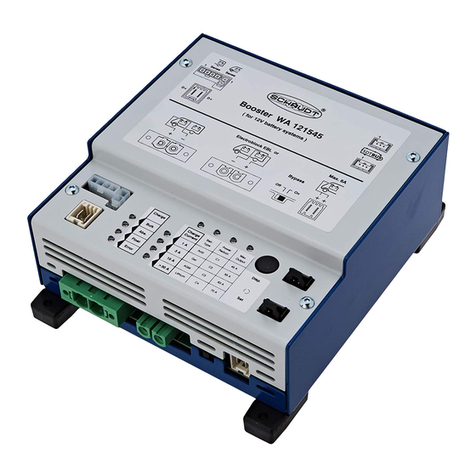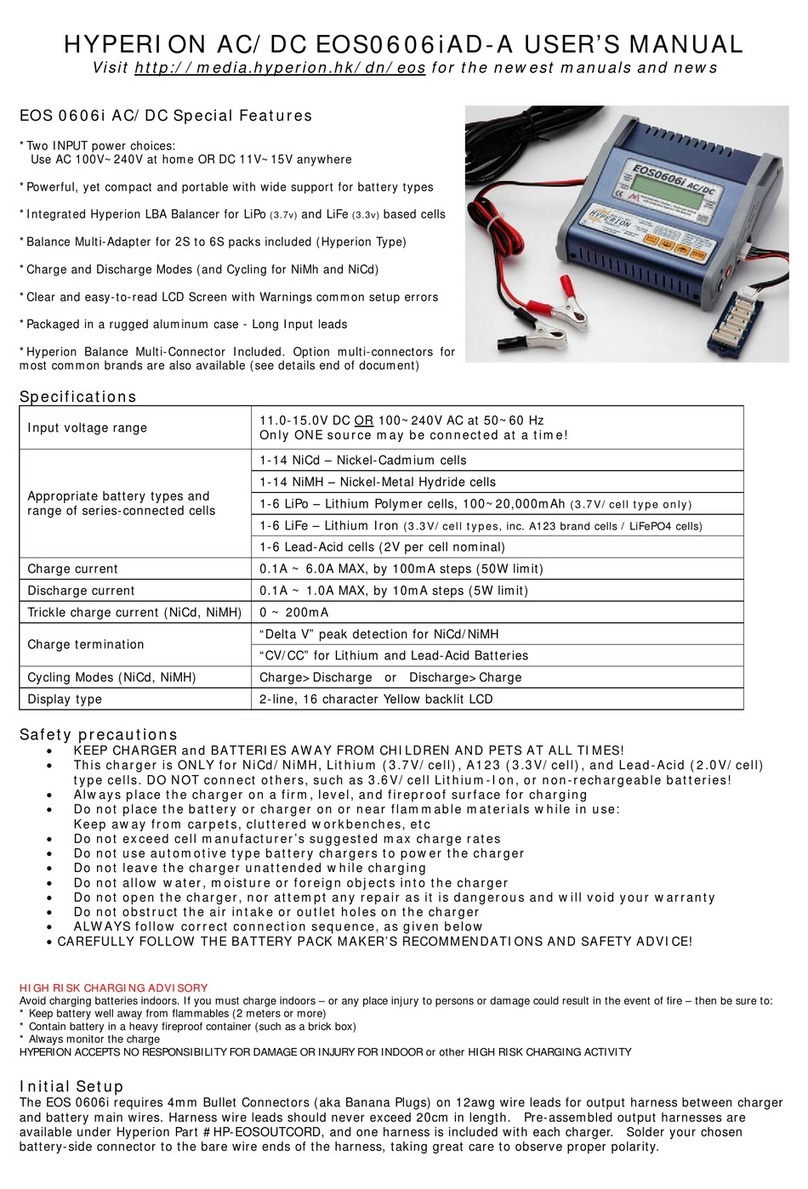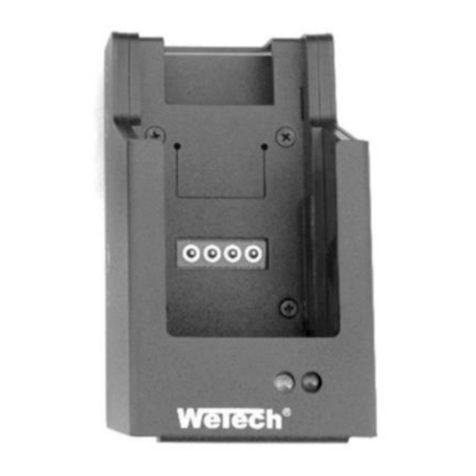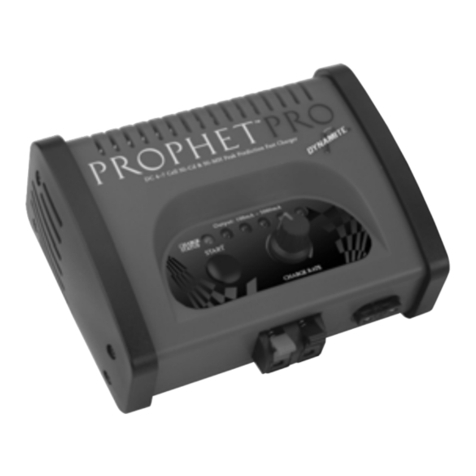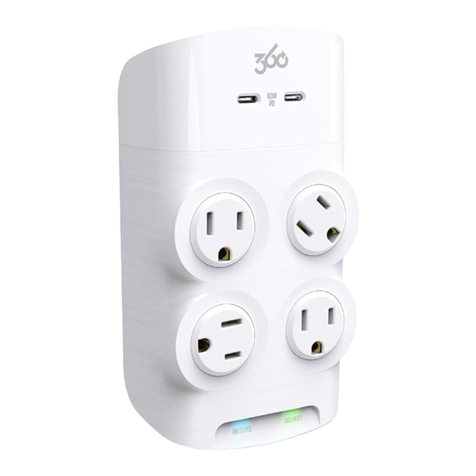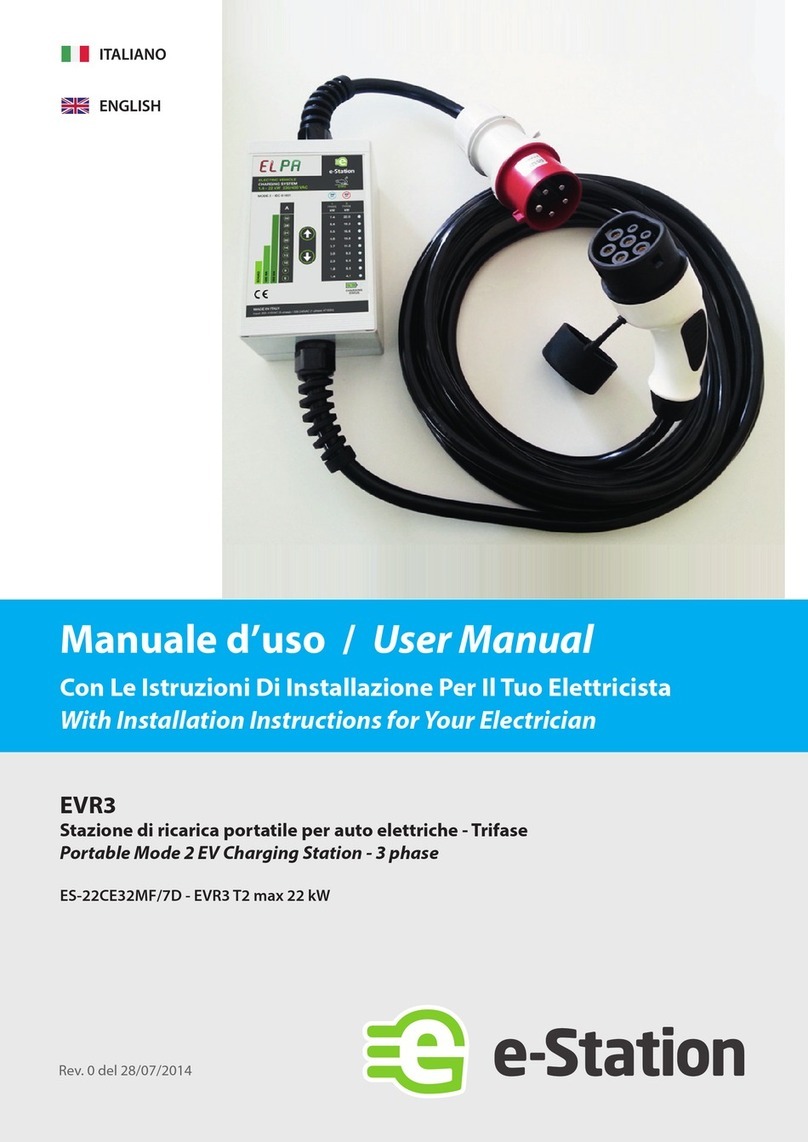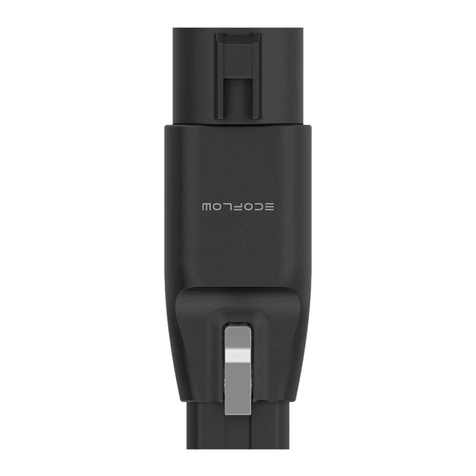Schaudt LAS 1218 BUS User manual

Date: 21.11.2018
ESchaudt GmbH, Elektrotechnik und Apparatebau, Planckstraße 8, 88677 Markdorf, Germany, Tel. +49 7544 9577-0, Fax +49 7544 9577-29, www.schaudt--gmbh.de
8100532 BA / EN
Operating and Installation Instructions
LAS 1218 BUS Battery Charger
Contents
1 Operating instructions 2...................................
1.1 Safety information 2......................................
1.2 Application and layout 3...................................
1.3 Operation 5..............................................
1.4 Maintenance 7...........................................
2 Installation instructions 8..................................
2.1 Introduction 8............................................
2.2 Mechanical installation 8...................................
2.3 Electrical connection 9....................................
2.4 Initial use 18..............................................
2.5 Technical details 20........................................
2.6 Storage, packaging and transportation 21.....................
Appendix 22..............................................

Operating and Installation - Battery Charger LAS 1218 BUS
2Date: 21.11.2018 8100532 BA / EN
1 Operating instructions
1.1 Safety information
1.1.1 Meaning of safety symbols
YDANGER!
Failure to comply with this sign may result in danger to life or physical con-
dition.
YWARNING!
Failure to comply with this sign may result in injury.
YATTENTION!
Failure to comply with the sign may result in damage to equipment or other
connected loads.
1.1.2 General safety instructions
The design of the device is state-of-the-art and complies with approved sa-
fety regulations. Failure to observe the safety instructions may nonetheless
lead to injury or damage to the device.
Only use the device when it is in perfect technical condition.
Any faults affecting the safety of individuals or the proper functioning of the
device must be repaired immediately by specialists.
YDANGER!
230V units carrying mains voltage.
Risk of fatal injury due to electric shock or fire:
FThe electrical system of the motorhome or caravan must comply with
DIN-, VDE- and ISO- regulations.
FConnect devices rated at 230V to the 230V supply in line with national
installation regulations.
FNever attempt to modify the device.
FOnly carry out electrical work once the 230V supply has been discon-
nected.
FNever try to start the device using a defective mains cable or a faulty
connection.
FNever undertake maintenance work on the device whilst it is still live.
FEnsure proper electrical connections are made.
FEnsure correct electrical fuses are used.
FThe mains connection line may only be replaced by an authorised cu-
stomer service department or by those qualified.

Operating and Installation - Battery Charger LAS 1218 BUS
3
Date: 21.11.2018
8100532 BA / EN
YWARNING!
Hot components
Burns:
FOnly change blown fuses when the device is fully de-energised
FBlown fuses may only be replaced once the cause of the fault is
known and has been rectified
FNever bypass or repair fuses
FOnly use original fuses rated as specified on the device or in these in-
structions.
FThe rear of the device may become hot during operation. Do not
touch it.
FNever store heat sensitive objects close to the device (e.g. tempera-
ture sensitive clothes if the device has been installed in a wardrobe)
1.2 Application and layout
1
4
5
78
2
3
6
Fig. 1 LAS 1218 BUS battery charger
1 Leisure area and starter battery connectors
2 Battery temperature sensor connector
3SDTBUS
connectors
4 Address switch (for use of charger in bus systems)
5 Indicator lamps for charging cycle
6 Two battery selector switches (A/B and 1/2)
7 Installation feet
8 Mains cable with earthing type plug or WAGO-connector (optional)
The LAS 1218 BUS battery charger is for charging suitable batteries during
230V operation or supplying 12V consumers without connected battery with
power.

Operating and Installation - Battery Charger LAS 1218 BUS
4Date: 21.11.2018 8100532 BA / EN
Different charging characteristics can be set with two battery selector swit-
ches for the perfect charging of different battery types. Temperature com-
pensation of these charging characteristics is realised with (optional) tempe-
rature sensor affixed to the battery, and results in additional optimisation of
battery charging at maximum battery protection.
The LAS 1218 BUS battery charger is aligned perfectly to Schaudt bus sy-
stems, and a corresponding connection to the SDTBUSlinks the device
into the system. This enables fully-automatic control of the entire charging
process with all chargers and batteries connected.
The LAS 1218 BUS battery charger is also excellently suited in conventional
systems and as standalone chargers.
YThis device is not intended to be used by those (including children) with
limited physical, sensory or mental aptitude or lack of experience and/or
knowledge unless they are supervised by a person responsible for their
safety or have received instruction from this person as to how the device
is used.
YChildren are to be supervised so as to ensure they do not play with the
device.
YThis device is intended for installation into a vehicle.
The device is a primary controlled switch-mode power supply unit. This mo-
dern switching technology achieves high charging performance at a compact
size and low weight.
The battery charger can be used:
Fas a battery charger for charging the leisure area battery and for re-
charging a connected starter battery
Fas an auxiliary charger for loading leisure area batteries with higher
capacities, suitable for every Schaudt EBL electroblock with an LAS
charger module (the possible number of auxiliary chargers depends
on the number of auxiliary charger connections on the respective
EBL)
Fas an auxiliary charger for charging leisure area batteries with higher
capacities, suitable for every SDTBUS-capable Schaudt EBL ...
electroblock (up to two auxiliary chargers can be connected here)
Fas a power supply unit (up to 18 A) for the 12V consumers connected.
No battery is required here.
The optional TF 25 A battery temperature sensor is used to implement bat-
tery temperature-controlled charging.
TF 25 A battery
temperature sensor
(optional)

Operating and Installation - Battery Charger LAS 1218 BUS
5
Date: 21.11.2018
8100532 BA / EN
1.3 Operation
1.3.1 Controls and indicator LEDs
The device has no controls which need to be used on a day-to-day basis.
The battery selector switches need only be set correctly on initial use and for
a change of battery.
YDANGER!
Risk of explosion!
FAn incorrect battery selector switch setting poses a risk of explosion
due to the formation of electrolytic gases.
YATTENTION!
FAn incorrectly set battery selector switch will damage the leisure area
battery.
FDisconnect the battery charger from the mains before moving the bat-
tery selector switch.
The LAS 1218 BUS charger may have to be reset when a battery type is
changed (see also Page 18).
Batteries may only be replaced by qualified personnel.
Follow the battery manufacturer’s instructions.
Charging unsuitable types of battery may damage them beyond repair.
It is possible to swap lead acid batteries with lead gel batteries.
Given the lack of ventilation options within the vehicle, changing from lead
gel to lead acid batteries is not possible without additional overhead.
Ask your dealer for advice.
The switching option provided by the battery selector switch ensures opti-
mum charging of the different battery types (lead-gel, lead-acid and AGM).
The indicator LEDs on the front of the battery charger show the current char-
ging phase.
This indicator LED lights up yellow in the ”Main Charge” and ”Full Charge”
phases.
This indicator LED lights up green in the ”Trickle Charge” phase.
YIn supply mode, the two LEDs switch alternately every second.
Changing the battery
Indicator LEDs
Main / Full charge
Trickle charge

Operating and Installation - Battery Charger LAS 1218 BUS
6Date: 21.11.2018 8100532 BA / EN
1.3.2 Faults
A fault in the power supply system is usually caused by a blown fuse.
Please contact our customer service address if you cannot rectify the fault
using the following table.
If this is not possible, e.g. if you are abroad, you can have the battery char-
ger repaired at a specialist workshop. In this case, you must ensure that the
warranty is not invalidated by incorrect repairs being carried out. Schaudt
GmbH will not accept any liability for damage resulting from such repairs.
Fault Possible cause Remedy
Leisure area battery is not
charged during 230V
o
p
e
r
a
t
i
o
n
(
b
a
t
t
e
r
y
v
o
l
t
a
g
e
No mains voltage Switch on the automatic
fuse in the vehicle
operation (battery voltage
constantly below 13.3 V) Have the mains voltage
checked
Battery charger is
defective
Contact customer service
Battery charger fuse or
wiring is defective
Have the fuse and cabling
checked
Leisure area battery is
overcharged during 230V
operation (battery voltage
rises to over 15V)
Battery charger is
defective
Contact customer service
Starter battery is not
charged during 230V
o
p
e
r
a
t
i
o
n
(
b
a
t
t
e
r
y
v
o
l
t
a
g
e
No mains voltage Switch on the automatic
fuse in the vehicle
operation (battery voltage
constantly below 13.0 V) Have the mains voltage
checked
Battery charger is
defective
Contact customer service
1
2
1
2
V
p
o
w
e
r
s
u
p
p
l
y
i
n
D
e
f
e
c
t
i
v
e
f
u
s
e
o
r
c
a
b
l
i
n
g
H
a
v
e
t
h
e
f
u
s
e
a
n
d
c
a
b
l
i
n
g
1212
V
power supp
l
y
i
n
t
h
e
l
e
i
s
u
r
e
a
r
e
a
d
o
e
s
n
o
t
D
e
f
ect
i
ve
f
use or ca
b
l
i
ng
H
ave t
h
e
f
use an
d
ca
b
l
i
ng
c
h
e
c
k
e
d
the leisure area does not
w
o
r
k
(
w
h
e
n
t
h
e
b
a
t
t
e
r
y
checked
work (when the battery
charger is being used as
a power supply device)
Battery charger is
defective
Contact customer service
No mains voltage Switch on the automatic
fuse in the vehicle
Have the mains voltage
checked
The ”Main / Full Charge”
indicator lamp does not
light up despite several
hours of charging
Battery charger is
defective
Contact customer service
Flat vehicle fuse

Operating and Installation - Battery Charger LAS 1218 BUS
7
Date: 21.11.2018
8100532 BA / EN
Fault RemedyPossible cause
The ”Trickle Charge”
i
n
d
i
c
a
t
o
r
l
a
m
p
d
o
e
s
n
o
t
System overloaded Switch off consumers
indicator lamp does not
light up despite several
hours of charging
Battery charger is
defective
Contact customer service
If the battery charger is
not defective:
Battery defective
Contact customer service
SDT ... bus system
fault messages:
E280 No LAS 1218 BUS on bus Check bus cabling
Contact customer service
E281 Battery temperature sen-
sor short-circuit*
Check cabling and
connectors
Contact customer service
E282 Battery temperature sen-
sor cable break or defec-
tive sensor*
Check cabling
Replace sensor
* For bus systems with another battery temperature sensor (e.g. with HELLA battery
sensor), the temperature value available on the bus is used as an alternative.
When a temperature sensor is connected:
Indicator lamps flash
quickly alternately
(
3
0
0
)
Battery temperature is too
high
Check battery ventilation
y
y
(approx. every 300 ms) Connector of temperature
sensor
defective/unplugged or
temperature sensor
defective
Check connector and
temperature sensor;
contact customer service
YThe charging current is reduced automatically if the device becomes too
hot due to excessive ambient temperature or lack of ventilation. Always
prevent the device from overheating nevertheless.
1.4 Maintenance
The battery charger is maintenance-free.
Clean the battery charger with a soft, slightly damp cloth and mild detergent.
Never use spirit, thinners or similar substances. Do not allow liquids to enter
the device.
Cleaning

Operating and Installation - Battery Charger LAS 1218 BUS
8Date: 21.11.2018 8100532 BA / EN
2 Installation instructions
2.1 Introduction
These installation instructions are aimed at trained personnel.
They contain important information on the connection and safe operation of
the device. The safety information provided must be observed.
Always follow the relevant instruction manual in addition to the installation in-
structions.
The following applications are described for the electrical connection (with
the appropriate deliverables):
FAuxiliary charger on electroblock (section 2.3.1.1)
FAuxiliary charger on electroblock in bus systems (Section 2.3.1.2)
FDirect connection to leisure area and starter batteries (Section
2.3.1.3)
FConnection to additional battery (e.g. when used in conjunction with
an inverter)
2.2 Mechanical installation
2.2.1 LAS 1218 BUS battery charger
YThis device is intended for installation into a vehicle.
The device is designed for floor installation.
Install in a dry, sufficiently ventilated location. No condensation is allowed
to form on the device. To prevent a build-up of heat, ventilation holes fa-
cing the leisure area must be provided in the upper and lower areas of
the place of installation. Its cross-section is based on the size and ave-
rage temperature of the place of installation.
Ensure a minimum clearance to the surrounding fixtures and fittings:
FMaintain a gap of at least 5 cm on all sides (except mounted side).
FWhilst in operation, the ambient temperature must not exceed +45 C,
measured 2.5 cm away from the sides of the device.
On a firm and level surface, tightly screw the battery charger with four
screws (5mm diameter).
Environment
Minimum clearance
Fitting

Operating and Installation - Battery Charger LAS 1218 BUS
9
Date: 21.11.2018
8100532 BA / EN
134,2
147,2
118,1
80
90
163,5
247,5
Flat pins 6.3 x 0.8
in the insulation housing
4 x attachment-
holes, ø4.5 Lumberg connector
Fig. 1 Dimension diagram for LAS 1218 BUS battery charger (dimensions in mm)
2.2.2 Fuse holder
For applications that require one or two additional fuses (see Section 2.3.1.3
for example), fuse holders from the connector set must be installed.
Determine the place of installation of the fuse holder(s). The place of in-
stallation must be in the direct vicinity of the corresponding battery.
Drill a hole 8mm in diameter for every fuse holder.
Lock the fuse holder into place in the drillhole.
2.3 Electrical connection
Establish the battery charger connection in the following order:
1. All connections on the front panel of the battery charger
2. Battery lines to the battery terminals
3. 230V mains connection
Disconnect in the reverse order.
Connection sequence
Disconnection

Operating and Installation - Battery Charger LAS 1218 BUS
10 Date: 21.11.2018 8100532 BA / EN
The following sets are available for different applications:
FPart number 999.308 for vehicles for which the 230V connector is a
Wago connector, and the auxiliary charger connector on the EBL has
an MNL connector
FPart number 999.305 for general upgrades with an additional charger
(on Schaudt EBLs with MNL or Minifit connector for additional charger
or for the direct connection to leisure and, where applicable, starter
battery)
FPart number 999.309 for vehicles for which the 230V connector is a
Wago connector, and the additional charger connector has an MNL or
Minifit connector; this connector set is also suitable for Schaudt bus
systems (SDTBUS)
2.3.1 General
YATTENTION!
Short-circuits can cause cable fire or damage to the battery charger. So the-
refore:
FTo protect the supply lines in the event of a short circuit, connect the
fuses directly to the positive terminal of battery.
Select cable cross-sections in line with EN 1648-1/-2. The maximum current
load must not exceed 90% of the individual fuse rating.
Recommended cable cross-sections:
Line length*
(sum of supply and return lines)
Cable cross-section
Upto4m 2,5 mm2
Up to 8 m (only for leisure area battery) 4,0 mm2
Up to 12 m (only for leisure area battery) 6,0 mm2
Fuse the supply lines as follows:
Fwith 1.5 mm2cable cross-section 10 A
Fwith 2.5 mm2cable cross-section (or greater) 20 A
2.3.1.1 Connection as for auxiliary charger to the electroblock
The LAS 1218 BUS battery charger can also be used as an auxiliary charger
for a Schaudt electroblock. Suitable for use here are all Schaudt electro-
blocks that include the LAS charger module and have the 2-pin MN connec-
tor (e.g. EBL 99) or Minifit connector (e.g. EBL 220) for an auxiliary charger.
See the operating instructions for the electroblock, ”Suitable accessories”.
Deliverables for
connector sets
Fuse protection
Auxiliary charger

Operating and Installation - Battery Charger LAS 1218 BUS
11
Date: 21.11.2018
8100532 BA / EN
3
2
1
Fig. 2 Parts required for LAS 1218 BUS as auxiliary charger to EBLs
Pos. Qty Name
1 1 LAS 1218 BUS battery charger, isolated ground
or WAGO connector (optional)
21* Connector cable, 1.7 m with Minifit connector
31* Connector cable, 1.7 m with MNL connector
* Pos. 2 and 3 as an alternative depending on electroblock to be connected
The connector cable (Pos. 2 or 3) is required to connect the LAS 1218 BUS
battery charger to the electroblock.
An additional fuse is not required as there is already one integrated in the
electroblock. You only have to check if the fuse is fitted and if it complies
with the fuse rating on the label.
The battery charger is connected to the electroblock with a 2-pin charger ca-
ble. Other lengths are available on request.
A connection to the starter battery is not required because the electroblock
already has the start battery recharge module.
Fuse protection

Operating and Installation - Battery Charger LAS 1218 BUS
12 Date: 21.11.2018 8100532 BA / EN
3
45
X
X
1 2
TF 25 A*
To EBL connector
”Additional charger”
Fig. 3 Connection diagram for LAS 1218 BUS battery charger -- to electroblock
1 Flat push-on contacts, 6.3 x 0.8, red cable
2 Flat push-on contacts, 6.3 x 0.8, brown cable
3 Not assigned
4 + Leisure area battery (red)
5 Negative battery (brown)
* TF 25 A battery temperature sensor is optional
2-pin charger cable: LAS 1218 BUS electroblock connection
F+ terminal LAS 1218 BUS leisure area battery: Flat push-on contact,
6.3 x 0.8; (Fig.3; Pos. 1)
F-- terminal LAS 1218 BUS: Flat push-on contact, 6.3 x 0.8; (Fig.3;
Pos. 2)
FMNL connector (view X, Fig. 3; Pos. 4/5) or Minifit connector on elec-
troblock, base ”auxiliary charger”; see also operating instructions for
electroblock
The following steps are only necessary when using the (optional) TF 25 A
battery temperature sensor:
Clamp the TF 25 A battery sensor to one of the terminals (preferable the
negative terminal) of the leisure area battery (note: this is NOT an electri-
cal connection -- only the temperature of the battery terminal is read with
this mechanical connection; this is virtually identical to the internal tempe-
rature of the battery)
Route the cable through the vehicle to the LAS 1218 BUS battery char-
ger.
Plug the TF 25 A battery temperature sensor into the LAS 1218 BUS bat-
tery charger.
Secure the battery sensor cable at suitable places (particularly near the
connector on the LAS 1218 BUS battery charger to prevent the 2-pin
connector from coming loose)

Operating and Installation - Battery Charger LAS 1218 BUS
13
Date: 21.11.2018
8100532 BA / EN
2.3.1.2 Connection as additional charger in SDTBUSsystems
The LAS 1218 BUS battery charger can also be used as an auxiliary charger
in a Schaudt bus system. Up to two additional LAS 1218 BUS chargers can
be connected to the EBL of the bus system.
YConnection to the SDTBUSfor Schaudt bus systems is possible from
the following software versions of the relevant bus system:
Bus system Software revision
SDT 213 V 3.XX and higher, Panel LT 13: V.3.01 and higher
SDT 630 V 3.XX and higher, Panel LT 6XX: V 3.02 and higher
EBL 6XX: V 3.02
The following parts are supplied for this application:
3
1
2
3
2
31
2
1
Fig. 4 Parts required for LAS 1218 BUS as auxiliary charger in bus systems
Pos. Qty Name
1 1 LAS 1218 BUS battery charger, isolated ground
or WAGO connector (optional)
2 1 Connector cable, 1.7 m with Minifit connector
3 1 SDTBUS(2 m) connector cable
An additional fuse is not required as there is already one integrated in the
electroblock. You only have to check if the fuse is fitted and if it complies
with the fuse rating on the label.
The battery charger is connected to the electroblock with a 2-pin charger ca-
ble. Other lengths are available on request.
A connection to the starter battery is not required because the electroblock
already has the start battery recharge module.
Auxiliary charger
Deliverables
Fuse protection

Operating and Installation - Battery Charger LAS 1218 BUS
14 Date: 21.11.2018 8100532 BA / EN
3
1 2
1
2
3
2
3
1
To EBL connector
To EBL connector
”Additional charger”
45
TF 25 A*
Fig. 5 Connection diagram for LAS 1218 BUS battery charger -- to electroblock
1 Flat push-on contacts, 6.3 x 0.8, red cable
2 Flat push-on contacts, 6.3 x 0.8, brown cable
3 Not assigned
* TF 25 A battery temperature sensor is optional
2-pin charger cable: LAS 1218 BUS electroblock connection
F+ terminal LAS 1218 BUS leisure area battery: Flat push-on contact,
6.3 x 0.8; (Fig.3; Pos. 1)
F-- terminal LAS 1218 BUS: Flat push-on contact, 6.3 x 0.8; (Fig.3;
Pos. 2)
FMinifit connector to electroblock, base ”Auxiliary charger”; see also
operating instructions for electroblock
3-pin bus cable: LAS 1218 BUS electroblock connection
F3-pin Lumberg connector must be plugged into LAS 1218 BUS,
SDTBUS (Fig.3;Pos.4)
F3-pin Lumberg connector must be plugged into electroblock,
SDTBUS(Fig.3;Pos.5)
The following steps are only necessary when using the (optional) TF 25 A
battery temperature sensor:
Clamp the TF 25 A battery sensor to one of the terminals (preferable the
negative terminal) of the leisure area battery (note: this is NOT an electri-
cal connection -- only the temperature of the battery terminal is read with
this mechanical connection; this is virtually identical to the internal tempe-
rature of the battery)
Route the cable through the vehicle to the LAS 1218 BUS battery char-
ger.
Plug the TF 25 A battery temperature sensor into the LAS 1218 BUS bat-
tery charger.

Operating and Installation - Battery Charger LAS 1218 BUS
15
Date: 21.11.2018
8100532 BA / EN
Secure the battery sensor cable at suitable places (particularly near the
connector on the LAS 1218 BUS battery charger to prevent the 2-pin
connector from coming loose)
2.3.1.3 Direct connection to leisure area and starter battery
For this type of connection, there is a direct connection between the LAS
1218 BUS battery charger and the two motorhome batteries (or also only
one battery, e.g. for a caravan).
The following parts are supplied under part number 999.086 for this applica-
tion:
4
1
76
5
23
Fig. 6 Parts for general upgrades
Pos. Qty Name
1 1 LAS 1218 BUS battery charger
2 7 Flat push-on contacts, 6.3 x 0.8 (blue)
3 3 Ring terminal, 1 ... 2.5 mm2M6
4 3 Ring terminal, 1 ... 2.5 mm2M8
5 2 Fuse holder for flat vehicle fuse
6 1 Flat vehicle fuse, 20A
7 1 Flat vehicle fuse, 10 A
The connector set (Pos. 2 to 6) is required to connect the LAS 1218 BUS
battery charger to up to two batteries.
YThe length of the line to the starter battery may not exceed 4 m (supply
and return lines together) for a cable cross-section of 2.5mm(see also
table on Page 10).
Deliverables

Operating and Installation - Battery Charger LAS 1218 BUS
16 Date: 21.11.2018 8100532 BA / EN
34
1
2
TF 25 A*
Fig. 7 Connection diagram for LAS 1218 BUS battery charger -- to leisure and starter batte-
ries
1Fuse F1
2FuseF2
3 Leisure area battery
4 Starter battery
* TF 25 A battery temperature sensor is optional
+ terminal LAS 1218 BUS leisure area battery (flat push-on contact 6.3 x
0.8) to F1 (flat push-on contact 6.3 x 0.8)
F1 (flat push-on contact 6.3 x 0.8) to + terminal of leisure area battery
(ring terminal, M6 or M8)
+ terminal LAS 1218 BUS starter battery (flat push-on contact 6.3 x 0.8)
to F2 (flat push-on contact 6.3 x 0.8)
F1 (flat push-on contact 6.3 x 0.8) to + terminal of starter battery (ring
terminal, M6 or M8)
Connection, LAS 1218 BUS to leisure area or starter battery
F-- terminal LAS 1218 BUS (flat push-on contact 6.3 x 0.8)
F-- terminal of battery (ring terminal, M6 or M8)
Label the two fuses with stickers ”F1 -- leisure area battery” and ”F2 --
starter battery”.
YThe negative terminal (--) of the leisure area battery must be connected
externally to the negative terminal (--) of the starter battery.
The following steps are only necessary when using the (optional) TF 25 A
battery temperature sensor:
Clamp the TF 25 A battery sensor to one of the terminals (preferable the
negative terminal) of the leisure area battery (note: this is NOT an electri-

Operating and Installation - Battery Charger LAS 1218 BUS
17
Date: 21.11.2018
8100532 BA / EN
cal connection -- only the temperature of the battery terminal is read with
this mechanical connection; this is virtually identical to the internal tempe-
rature of the battery)
Route the cable through the vehicle to the LAS 1218 BUS battery char-
ger.
Plug the TF 25 A battery temperature sensor into the LAS 1218 BUS bat-
tery charger.
Secure the battery sensor cable at suitable places (particularly near the
connector on the LAS 1218 BUS battery charger to prevent the 2-pin
connector from coming loose)

Operating and Installation - Battery Charger LAS 1218 BUS
18 Date: 21.11.2018 8100532 BA / EN
2.3.2 Mains connection
YDANGER!
230V units carrying mains voltage.
Risk of fatal injury due to electric shock or fire:
FOnly carry out electrical work once the 230V supply has been discon-
nected.
The mains must be connected as follows:
Fto a insulated distribution unit with protective contact
Fto a socket with protective contact (isolated ground or suitable plug
connector from WAGO, depending on LAS 1218 BUS variant).
The power cord must be of type H05VV-F 3x1.5.
The mains cable must have a strain relief where required.
2.4 Initial use
2.4.1 Checks prior to initial use
Ensure that the batteries are connected properly (only for initial use, ope-
ration without battery is possible in general).
2.4.2 Setting battery type
Determine the battery type
YDANGER!
Incorrect setting of the battery selector switch.
Risk of explosion from build-up of electrolytic gas, defective battery, defec-
tive battery charger or as a result of too high a battery operating tempera-
ture (above 305 C):
FMove the battery selector switch to the correct position.
Store batteries in a place that is sufficiently ventilated (or provide integra-
ted ventilation). Follow the instructions provided by the battery manufac-
turer.
Fig. 8 Battery selector switch
Mains connection
Prior to use

Operating and Installation - Battery Charger LAS 1218 BUS
19
Date: 21.11.2018
8100532 BA / EN
Disconnect the battery charger from the mains before moving the battery
selector switch.
YHowever, suitability must be checked using information from the battery
supplier and the charging parameters of Schaudt equipment. The char-
ging parameters are specified in the operating and installation instruc-
tions.
Move the battery selector switch (see Fig. 8) to the correct position using
a thin object, such as a ball point pen:
B
a
t
t
e
r
y
t
y
p
e
s
e
t
*
Switch positions
B
attery type set
*
Switch 1/2 Switch A/B
Supply mode 1 A
AGM2 1 B
Lead-gel / AGM1 2 A
Lead-acid 2 B
* See also the table in Section 2.5.2 ”Technical details”.
YIn supply mode, the charge regulator supplies a constant output voltage
YThe two switches are recessed in the housing to eliminate incorrect ope-
ration. A small screwdriver may have to be used to switch setting.
Then re-check that the battery selector switch is in the correct position for
the type of battery used.
2.4.3 Setting the address
When a LAS 1218 BUS is used in Schaudt bus systems, every device con-
nected to the SDTBUShas an ”address”.
Set the ”Auxiliary charger” address switch as follows:
One LAS 1218 BUS battery charger as an auxiliary charger:
Move the ”Auxiliary charger” switch to Pos ”1”
Two LAS 1218 BUS battery chargers as auxiliary chargers:
Move the ”Auxiliary charger” switch on one device to Pos ”1”
Move the ”Auxiliary charger” switch on the other device to Pos ”2”
The switch position is not important when the LAS 1218 BUS battery char-
ger is used in conventional systems.
2.4.4 Starting up the system
Ensure that the battery is connected correctly (or all if more than one is
available).
230V mains supply must be connected to vehicle.
Switch on the electrical system of the vehicle (e.g. turn on the main 12V
switch on the control panel -- refer to the operating instructions for the
control panel connected).
230V mains cable of the LAS 1218 BUS charger must be connected (the
charger does not have its own mains switch).
Battery selector switch
Address switch

Operating and Installation - Battery Charger LAS 1218 BUS
20 Date: 21.11.2018 8100532 BA / EN
Check whether the batteries are being charged (display on the battery
charger).
2.5 Technical details
2.5.1 Mechanical details
Approx. 90 x 148 x 248 (H x W x D in mm), including attachment feet
1.0 kg
Polyamide blue, similar to RAL 5010
2.5.2 Electrical details
230 V AC voltage +10%, 47 -- 63 Hz sinusoidal, protection class I
1.9 A
6-cell lead-acid, lead-gel or AGM batteries, 55 Ah and above
Approx. 0.3 mA
Conditions for the measurement:
FApprox. 10 minutes after mains isolation without mains connection
Fwith battery connected (battery voltage 12.6V)
12V outputs A maximum of 90% of the nominal
current of the relevant fuse may be
drawn.
Leisure battery
Charging curve IUoU
End-of-charge voltage* Between 14.45V and 14.75V @ 22.5C bat-
tery temperature (and without temperature
sensor)
Charge current 18 A in the entire mains voltage range,
electronically limited, minus the
charge current into the vehicle battery
Voltage trickle charging* Between 13.55V and 13.75V @ 22.5C bat-
tery temperature (and without temperature
sensor), with automatic switchover
New charging cycle, As soon as the charging current is limited,
switchover to main charging switchover to main charging
with delay
* Dependent on the battery type set
Main charge
I
Full charge
Uo
Trickle charge
U
See table
Time
Charge voltage
Trickle charge voltage
Ucharge
V
Fig. 9 Example of the charge voltage behaviour with the LAS 1218 BUS battery charger
Dimensions
Weight
Casing
Mains connection
Current consumption
Suitable batteries
Standby current from
leisure battery
Current-carrying
capacity
Battery charging via
mains connector
Table of contents
Other Schaudt Batteries Charger manuals
Popular Batteries Charger manuals by other brands
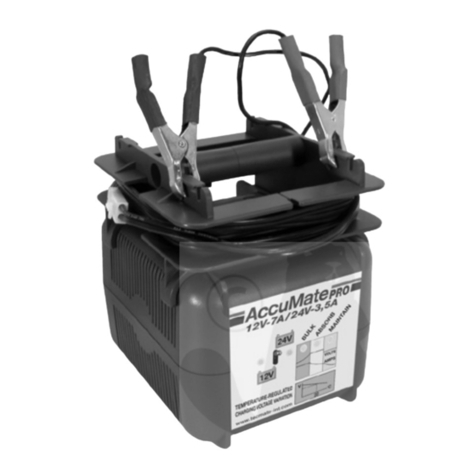
AccuMate
AccuMate PRO 12/24 Instructions for use
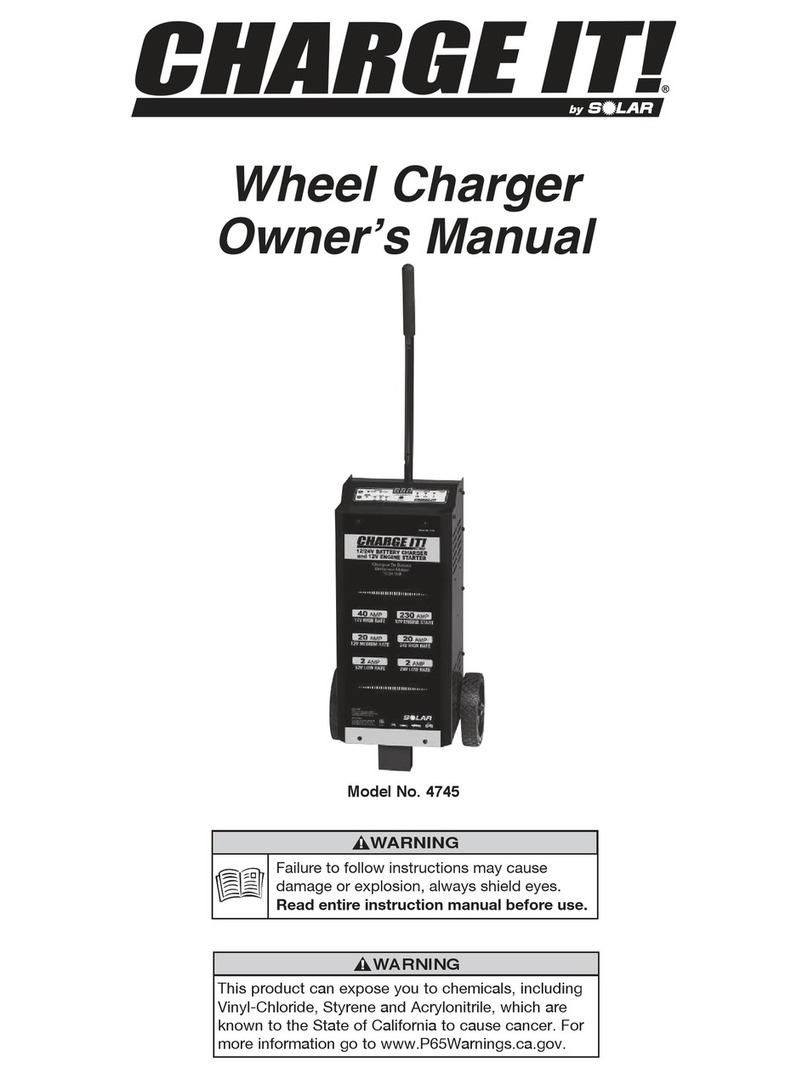
Solar
Solar Charge IT! 4745 owner's manual
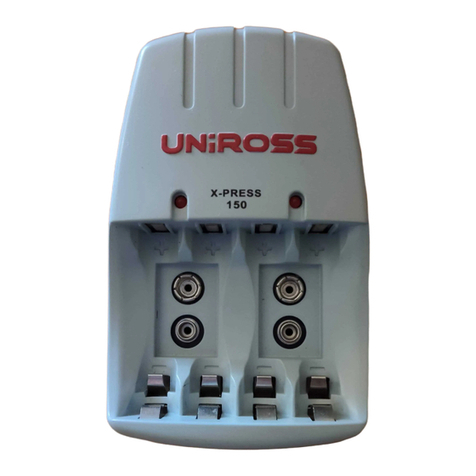
UNIROSS
UNIROSS X-PRESS 150 Important safety instructions
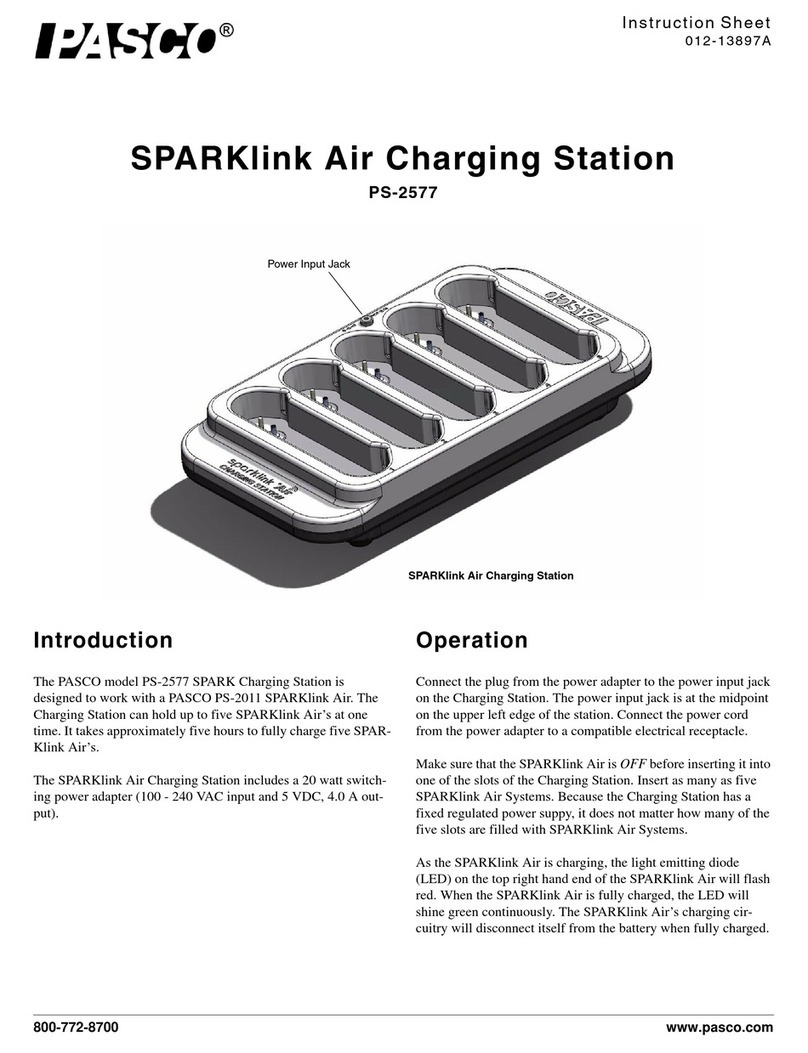
PASCO
PASCO SPARKlink Air PS-2577 instruction sheet
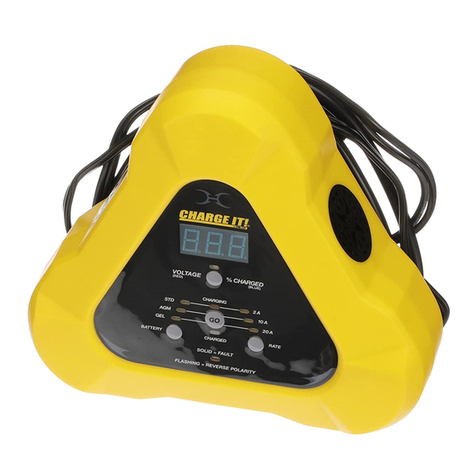
Charge IT
Charge IT 4506 owner's manual
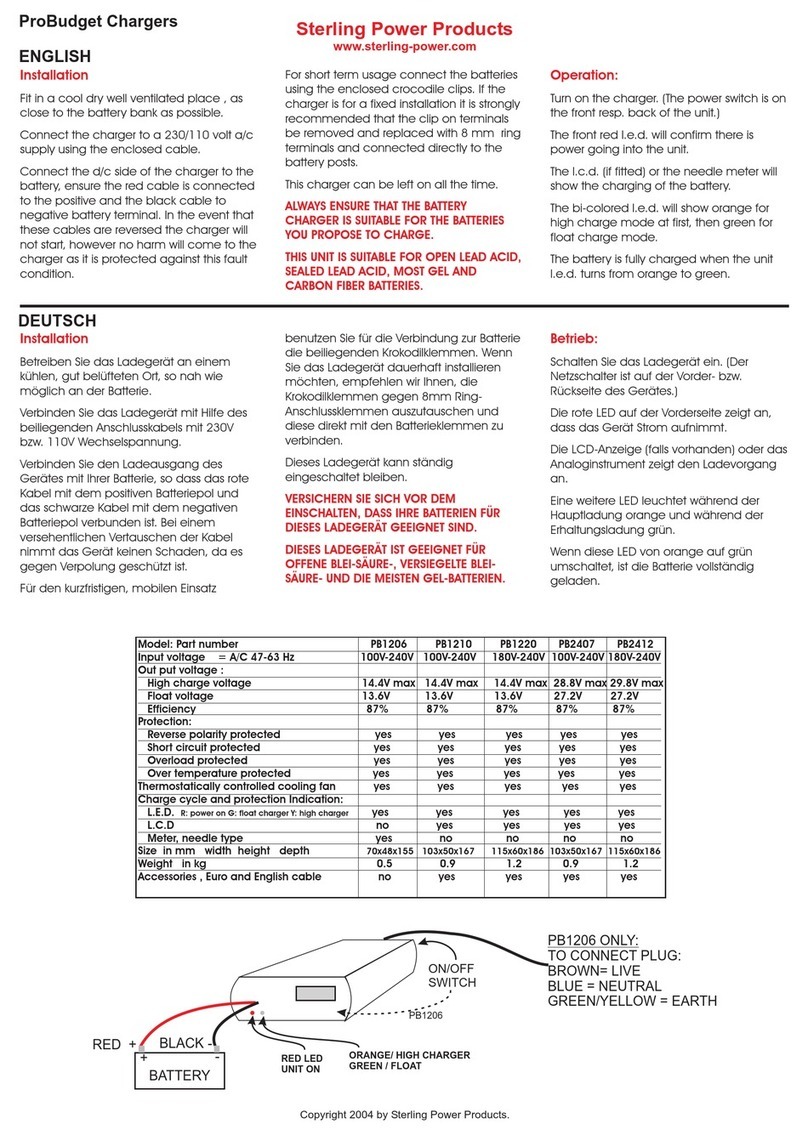
Sterling Power Products
Sterling Power Products PROBUDGET PB1206 user manual



